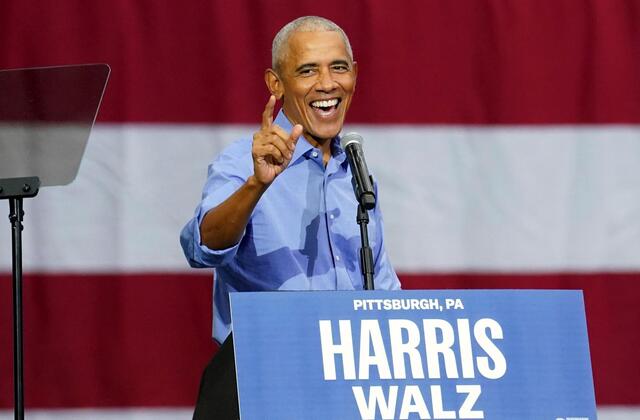Democratic presidential candidate Kamala Harris will join forces with former President Barack Obama and former First Lady Michelle Obama in a series of campaign events next week, marking the first time the trio will appear together as part of her 2024 campaign. This strategic move, designed to inject star power into the final phase of the election, aims to rally Democratic voters as Harris battles in a closely contested race against Republican rival Donald Trump, a senior campaign official confirmed.
The Obamas, who remain highly popular within the Democratic Party, are seen as key figures in energizing the party’s base. Their influence could prove pivotal in driving voter turnout, particularly in swing states where the margin for victory is expected to be razor-thin. Polls indicate that the race between Harris and Trump remains extremely tight, with both campaigns focusing on mobilizing their most loyal supporters in the final weeks.

Michelle Obama will make her first campaign appearance of the election cycle on October 26 in Michigan, where she will join Harris for a rally. The former first lady has stayed mostly out of the political spotlight this year but delivered a powerful and pointed speech at the Democratic National Convention in Chicago earlier, in which she accused Trump of using fear and division as his primary political tools. Her appearance with Harris in Michigan, a key battleground state, underscores the importance of shoring up support among Democratic voters in states where every vote will count.
Barack Obama, meanwhile, will campaign alongside Harris in Georgia next Thursday, continuing his whirlwind tour of key battleground states. He has already made solo appearances, including a recent event in Pittsburgh, and plans to visit additional cities in the coming days, including Tucson, Las Vegas, Detroit, and Madison. His involvement in the final stretch of the campaign reflects the former president’s ongoing popularity and ability to galvanize voters, particularly in areas with large Black and minority communities.

However, Obama has faced some criticism for remarks he made during an earlier campaign stop, where he expressed frustration with a segment of Black men who, in his view, were not fully embracing the idea of a woman becoming president. His comments were met with backlash from some corners of the Democratic Party, with critics arguing that his tone risked alienating a crucial voting bloc that remains essential to the party’s success. While many Black voters remain reliable supporters of the Democratic Party, some have become disillusioned, and Obama’s remarks were seen by some as counterproductive in efforts to persuade these voters to turn out for Harris.
Despite the controversy, the Obamas’ support remains a major asset for Harris. Barack Obama has long been a political mentor to Harris, who was an early supporter of his 2008 presidential run. Since then, he has quietly offered guidance to Harris, particularly as she emerged as the Democratic Party’s 2024 presidential nominee following President Joe Biden’s decision not to seek re-election. Biden’s withdrawal from the race came after growing concerns within the Democratic Party about his age and ability to lead, particularly after a widely criticized debate performance against Trump in June.

As Election Day approaches, the Harris campaign is banking on the Obamas’ ability to serve as “closers,” helping to energize Democrats and drive high turnout in key states. With polls showing a tight race, both campaigns are focused on mobilizing their core supporters in the remaining weeks. The Harris campaign, in particular, is relying on high turnout from loyal Democratic voters, including African Americans, women, and young voters, many of whom view the Obamas favorably.
The campaign’s strategy reflects the importance of swing states like Michigan and Georgia, where Harris and the Obamas will make appearances next week. In Michigan, Democrats are hoping to build on the momentum from their success in 2020, while Georgia has become an increasingly competitive state, thanks in part to demographic shifts and strong voter mobilization efforts led by figures like Stacey Abrams. Harris’ upcoming joint appearances with the Obamas signal the campaign’s commitment to winning these key battlegrounds.

Meanwhile, Trump continues to campaign vigorously, focusing on mobilizing his base and appealing to swing voters. The former president remains popular with Republicans, and his rallies continue to draw large crowds. Both campaigns are aware that the outcome of the election could hinge on voter turnout, making the final days before November 5 crucial.
As the race tightens, the involvement of the Obamas provides Harris with a significant boost. Their popularity, particularly within the Democratic base, could help counter some of the challenges Harris has faced in attracting a broad coalition of voters. In particular, Michelle Obama’s no-nonsense approach and her ability to connect with voters on a personal level could prove effective in rallying key demographics, including women and minority voters.
With just weeks to go before Election Day, the Harris campaign is pulling out all the stops to secure a victory. The upcoming appearances with the Obamas are seen as a key part of this effort, as the campaign looks to capitalize on their star power and rally the Democratic base in what promises to be one of the most closely contested elections in recent history.




